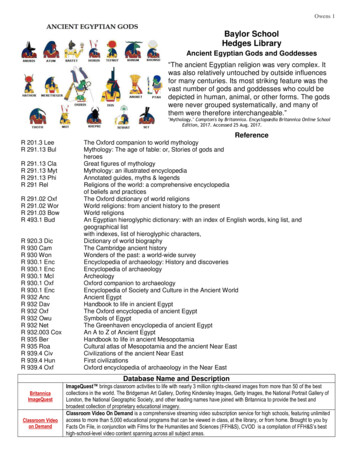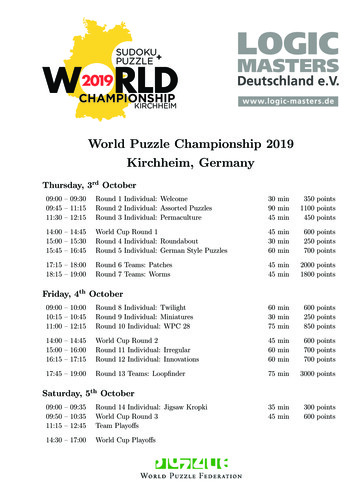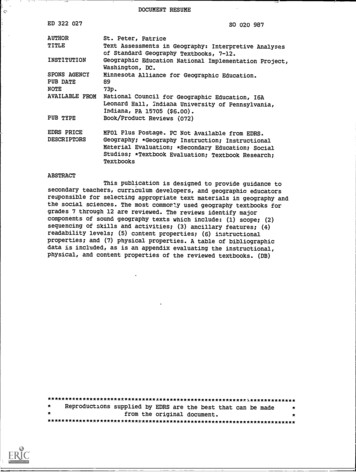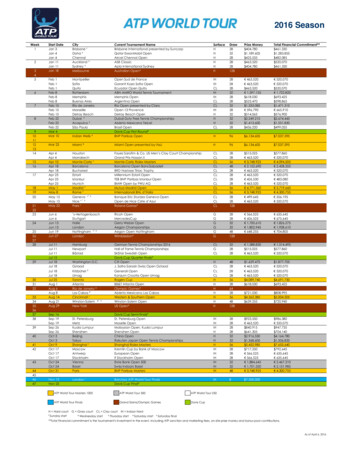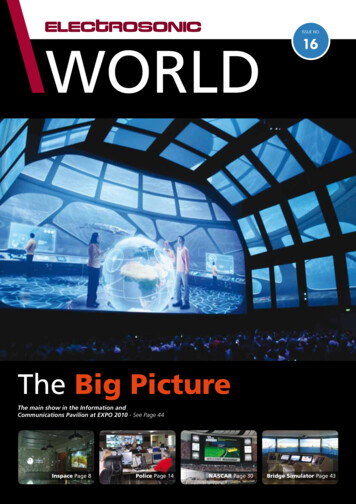
Transcription
WORLDThe Big PictureThe main show in the Information andCommunications Pavilion at EXPO 2010 - See Page 44Inspace Page 8Police Page 14NASCAR Page 30Bridge Simulator Page 43
WORLDISSUE NO.16WelcomeEditorialto the 16th Edition of ELECTROSONIC WORLD. ThisThe role of ELECTROSONIC WORLD has always beenedition sees a change in format. For 30 years it hasto share the company’s experience amongst its staff,appeared tabloid style, but it is hoped that the newcustomers, suppliers and friends. As a by-product it hasA4 format will make it more convenient for filing andbecome both a potted history of AV and a valuablereference. The wide range of exciting projects thatresource. Back numbers are often trawled for ideasElectrosonic has completed recently has resulted in aor for reminders of “how it was done”! Electrosonic“bumper edition”.always acknowledges that it cannot succeed in isolation,and that all its best opportunities arise from a vibrantThe new format also marks a landmark in Electrosonic’screative and consultant community. ELECTROSONICdevelopment. Since the last edition Electrosonic hasWORLD provides an opportunity for the companymade several major changes including the sale ofto recognize the team basis on which most work isits products division and significant investment inundertaken. Mention of particular products recognizesexpanding the scope of the overall business. Thethe importance of the industry at large and the amazingcompany’s 450 employees are now totally focused ontechnical progress that has been made over theproviding the highest standard of service in the supportyears – but it must be emphasized that Electrosonic isof complex AV installations right through their life“vendor neutral”, and always seeks to supply the mostcycle.appropriate products for the job in hand.Parting WaysIn early 2010 Electrosonic withdrewfrom manufacturing its own products,marking the end of 46 years ofinnovative product development. It trulywas a “parting of the ways”.When Electrosonic started in 1964 all itswork could be classed as “systems andservice”, consisting as it did of providingspecial solutions for sound, lighting and theprojected image; supported by service andrental.But these were the days before electroniclighting control, integrated circuits andlow cost video. Very often there were noproducts to realize a project and everythingwas custom built. So Electrosonic enteredthe products business, both to meet newneeds and to level out the uneven nature ofprojects work.The first product was an automatic electronicdimmer, based on the then new siliconcontrolled rectifier (later called a thyristor).This was the foundation of a highlysuccessful lighting control business withmany notable contributions to the art; inparticular the practical realization of “scenesetting” products for the architecturalmarket.22Electrosonic Company NewsIn 1990 majority ownership of Electrosonicpassed to Helvar of Finland, and during the1990s the lighting control products weretaken over by Helvar, where their successorsstill thrive (see www.helvar.com). Notethat today Electrosonic Group is entirelyindependent of Helvar, although havingindividual shareholders in common.Expertise in electronic lighting control ledto the development of “dissolve units”for controlling automatic slide projectors(particularly the Kodak Carousel ). Suchdevices formed the basis of professional AVfor many years, and led to a range of “multiimage” and “show control” products.The arrival of the laser disc in the mid 1980swas the key to Electrosonic’s entry to thevideo world, and for 20 years it had a strongposition in the “videowall” market withinnovative products such as PICBLOC andVECTOR .These in turn led to image processingand source products being the focus ofdevelopment, with, latterly, an emphasis onimage transport over networks. However thisniche business raised a major problem. Itsproducts went to market through systemsintegrators, and Electrosonic as a majorsystems integrator found itself competingwith its customers (apart from itself wantingto be seen to be independent of particularproducts when engineering systems).So while in the “old days” it proved possibleto simultaneously run a products and asystems business, new technology andthe current market structure make it verydifficult. Electrosonic was, therefore, verypleased that Extron Electronics acquired theElectrosonic products business, since thisensured the continued availability of someexciting products, and retained the talentedindividuals responsible for them.It is important to understand that thetransaction was a simple asset sale. Thereis no connection between Electrosonic andExtron Electronics other than by way ofnormal trade, and Electrosonic has the samestatus as any other Extron reseller.The ES3601 AV presentation unit from the 1970sElectrosonic World Issue 16
ContentsDigital Video at Sea P9SHOC in Africa P16Beyond all Boundaries P22Exploration Space P32Dolphin Tales P40ELECTROSONIC COMPANY NEWS2Parting Ways - sale of the products business2Corporate Solutions Expansion - new acquisitions4DRV and Excel Media5CORPORATE, COMMERCIAL, MEDICAL AND ACADEMIC6TAQA meeting rooms in Aberdeen6Horizon Centre at Torbay Hospital7Inspace at Edinburgh University8Princess Cruises - Digital video at sea9Total Health at Kaiser Permanente10Port of Los Angeles11Factory tests of AV systems12Burbank Studio12CONTROL ROOMS12New control room demonstration facility12Signal training for London Underground13Derbyshire Police14Service Operations Center at Electrosonic14TAQA Emergency Response Centre15SHOC in Africa for the World Health Organization16MUSEUMS17Denver Museum of Nature and Science17National Museum of American Jewish History18Museum of London20Museum of the Order of St John21World War II Museum in New Orleans22Robert Burns Birthplace Museum24National Museum of the American Indian, New York25Museum of the Moving Image, New York26Great North Museum: Hancock28VISITOR CENTERS29Scotch Whisky Experience29NASCAR Hall of Fame30Exploration Space at the Kennedy Space Center32Firing Room Theater at the Apollo/Saturn V Center34Jodrell Bank radio telescope35Royal Botanic Gardens Edinburgh35ENTERTAINMENT36THEA Awards - Harry Potter363D at Skistar’s Experium36Flying rides at OCT Parks in China37Kuwait 360 Mall38Dolphin Tales40Shipbuilding Pavilion at EXPO 201042Information and Communications Pavilion at EXPO 201044USA Pavilion at EXPO 201046
Corporate SolutionsExpansionIn the period 2009-2011 Electrosonic madesome significant changes to the way itoperates. These were all designed to focusthe business, both in terms of activitiesand markets. One major change was towithdraw from the products business,as explained on page 2. Another was tointroduce a market led approach with2the idea that wherever in the world acustomer required the company’s services,the customer could expect to receive aconsistent high level of service.The principal markets now served by Electrosonicare for convenience labeled “CorporateSolutions”, “Entertainment” and “ControlRooms”, and of these it is “Corporate Solutions”that has seen some of the biggest changes,involving a considerable increase in resources.31Corporate Solutions specializes in the communications needsthe company to offer new services. The merger of operationsof the Financial and Professional Services “industry”, but alsohas been based on best practice within both companies.undertakes work in the medical, commercial and academicfields. The technologies deployed include all types of electronicimage displays, audio and video conferencing equipment, roomcontrol systems, source and distribution systems, and networkcontrol and content distribution.The strengthening of the corporate market offering has alsoinvolved the location of support closer to the customer base.DRV had a useful base in the London Docklands area, withinwalking distance of many important customers. This facilitynow supports all Electrosonic customers in the Canary WharfMany of these systems are “state-of-the-art”, using the latest“cluster”. At the same time Electrosonic’s City of Londontechnology whether it be in 4K projection or sophisticatedoffice has been relocated from Queen Victoria Street toaudio DSP. Unfortunately it is not possible to describe much ofClements Lane. The new location has good meeting and “hotthis work in ELECTROSONIC WORLD for reasons of customerdesk” facilities and is a valuable resource for all divisions ofconfidentiality.Electrosonic.In April 2010 Electrosonic acquired the Multimedia Group, aIn April 2011 Electrosonic announced that it had acquired Excelcompany trading under the name DRV. Its prime business wasMedia of New York City. Excel Media came with an excellentthe support of corporate installations in the United Kingdom,reputation for providing system integration and supportand its activities were complementary to those of Electrosonicservices to New York based clients, and this strategic acquisitionin the same market. The acquisition has resulted in a muchfurthers Electrosonic’s aim to provide global clients withenlarged presence in the UK corporate market, and has allowedexperienced local support.Photograph 1: Imposing entrance to the New York office. 2: The building in Clements Lane that houses Electrosonic’s City of London office.3: Inside the City of London office.44Electrosonic Company NewsElectrosonic World Issue 16
The DRV StoryExcel MediaDRV started as a partnership betweenDavid Roffey and Roger Vintonwho had been to school together inNewquay (Cornwall, UK). While therethey had provided lighting and soundfor school and community shows.Roger Vinton himself went on to be1a trainee technician at the NationalYouth Theatre followed by attachmentsto Sadler’s Wells and the Young Vic.This solid grounding helped define thecompany’s initial objectives when RogerVinton returned to Cornwall; from thenon Roger Vinton would be principal“front man” and David Roffey would2be in charge of operations.Early business was in Public Address,providing both a hire service andThe same period saw DRV’s first workdesign consultancy. This soon led toat the National Exhibition Centre, nearpermanent installation work for clientsBirmingham, which led to a permanentThe company Excel Media was foundedsuch as the Theatre Royal in Plymouth.on site presence, and also thein 1995 by AV industry veteran Robertcompany’s first entry into the financialMenell. It specialized in the design andservices market. This activity was toinstallation of meeting room systems,grow into a business employing morevideo conferencing systems, and digitalthan 100 people with many blue-chipsignage. Its location meant that itclients sited in various locations, butcould provide support for clients in theprimarily based in the City of LondonNew York tri-state area, with particularand the London Docklands.emphasis on Manhattan.highlights being the completion ofDRV developed a number of innovativeFor some time Electrosonic had beenthe audio systems for the Bridgewaterofferings, including 24/7 “real” (notlooking for ways to introduce itsHall in Manchester in 1996, and worktelephone) support for its customers;corporate market offering to the Newin medical teaching installations atthese are now being extended to theYork market. The company realizedImperial College around the same time.enlarged Electrosonic client base.that to provide a credible offeringFor some years DRV consisted of twocompanies, one a hire business, theother for permanent installations,however in 1991 the hire businesswas closed. The 1990s were to seeconsiderable expansion in both thesize and scope of the company, withit was essential to base it on a teamalready experienced at working inNew York, and was delighted whenthe opportunity to purchase ExcelMedia arose - especially since the Excelapproach to customers was so similarto that of Electrosonic.Excel Media (now Electrosonic) has animpressive range of regular customers,including media companies, financialservice companies and universities.Electrosonic’s existing staff in the NewYork area have joined the operationand the combined team totals 25people in mid 2011.Main Photograph: The Cannon Workshops listed buildings on Canary Wharf; DRV’s (and nowElectrosonic’s) base for providing support service to Docklands customers. 1: The Newquayoffices, set in glorious Cornish countryside. 2: The Bridgewater Hall, one of DRV’s major audioinstallations in 1996. Photo P. Mackinven Arup.ESWorld: Corporate,Medicaland AcademicElectrosonicWorld Issue16Photograph: The building housing Excel Media(now Electrosonic) offices in Manhattan.Electrosonic Company News5
TAQAMeetingsTAQA Bratani is becoming a leadingexploration and production companyworking in the oilfields of the UnitedKingdom Continental Shelf. Its rapidexpansion has led to its occupationof three new buildings in the ArnhallBusiness Park just outside Aberdeenin Scotland, all of which have neededAV facilities. Electrosonic has beenthe systems integrator for much ofthis work, supplying a digital signagesystem and fitting out 20 meetingrooms, a complete conference suite,an emergency control room, and avideo conferencing suite.The installation in the conferencesuite is of particular interest since itprovides great flexibility with ease ofuse in a difficult building layout.The installation has to provide for sixindependent meeting rooms that canbe set up in boardroom style for groupsof between eight and twenty people. Asystem of movable partitions allows therooms to be linked to cater for largergroups. At the extreme the whole suitebecomes one large room suitable for“Town Hall” meetings where up to 150people can be addressed.An early decision was to provide only thelargest space with full control facilities,which also acts as “master” control whenrooms are combined. All the other spaceshave relatively simple facilities.The largest space is “Gleneagles” andthis is equipped with an AMX wirelesstouch panel that can control this space,and also set up linked spaces.12The photo of the control panel below,shows the room set-up page. Thesix spaces are clearly presented, as isthe facility to “join” rooms together,achieved by simply selecting the “join”function and touching the rooms that areto be joined. The principal function of“joining” is to link both lighting controland audio in the combined space.Both the Gleneagles and Glenroyalrooms are fitted with ceiling mountedNEC NP4100W WXGA projectors andmotorized ceiling mounted screens.The smaller rooms are served by trolleymounted NEC 46 inch LCD displays, whichcan also be used as repeater screenswhen rooms are combined.A mobile video conferencing trolley,based on LifeSize equipment and fittedwith an NEC 52 inch LCD display can beused in any room but normally “lives” inthe Gleneagles room. The audio system isbased on the use of Tannoy CMS501BMceiling loudspeakers fed by either Crownor Australian Monitor amplifiers at100V. Audio mixing and routing is by aPolycom C16 Soundstructure. Conferencemicrophones are Polycom HDX ceilingarrays, but for presentations wirelessmicrophones (lapel and handheld) areavailable.The central equipment is housed ina compact mobile rack sited in theGleneagles room. Each room is fittedwith a hard wired control panel for thesimple control facilities required, butbecause these cannot be mounted onthe movable partition walls, they arenecessarily mounted on the outside walls.The AV and control system is provingeffective in use, aided particularly by theexcellent programming of the controlpanel. The rooms are intensively used,with frequent re-arrangement of thespace. Electrosonic’s Edinburgh office wasresponsible for the main installation andcontinues to provide support service.34Main photograph: The entire suite opens up as a single meeting space for a “Town Hall”meeting. The partitions can be seen in their storage position in the left and right corners. Photocourtesy TAQA Bratani Ltd, 1: The TAQA building housing the conference suite. 2: The conferencesuite center corridor when all partitions are in place. 3: The Gleneagles room. The VC trolleyshown to the left of the main screen can be moved to other rooms when required. The centralequipment rack can also be seen. 4: The wireless touch panel room set-up page.6Corporate, Commercial, Medical & AcademicElectrosonic World Issue 16
Main photograph: The control room of thesimulated operating theatre. 1: The simulatedward. 2: External view of The Horizon Centre.3: The reception area includes wayfinding screens.The South Devon Healthcare NHS Trust recently opened TheHorizon Centre - Centre for Innovation, Education & Research atTorbay District Hospital in the UK. DRV (now part of Electrosonic)was appointed audio visual systems integrator for the newcentre.in Torbay1The facilities provide a completely integratedThe system allows fully interactiveanaesthetist training scenarios to be runand recorded, and then played back fordebriefing. Users have the ability to monitor,interact with, record and replay trainingsessions throughout the building, to link tooutside sites via video conferencing, andto master recordings of these events toWindows Media for webcasting and videoon-demand.system consisting of eighteen linkedinteractive teaching spaces, centred arounda simulated operating theatre and simulatedward.DRV (now Electrosonic) has a longrelationship with Torbay Hospital, havinginstalled and maintained teaching facilities atthe site for over ten years. DRV was involvedfrom the early stages of planning for thenew centre, working with medical teachingconsultants MedicVision to develop a designfor the leading edge AV systems within thecentre.The scope of work included digital signage,a room booking system, and fully integratedmultimedia systems for teaching andpresentation within a central technicianoperated AV Control Room, a SimulatedOperating Theatre, a Simulated Ward, aLecture Theatre, a Briefing Room, ProceduralSkills Rooms, and Tutorial and MeetingRooms.Electrosonic World Issue 16The systems installed at the Horizon Centreare tailored to the special needs of medicaltraining. The main task of the system is torecord the simulation activities in a digitalformat from multiple camera locations aswell as any biometric information derivedfrom high fidelity mannequins. Recordingsare synchronized to allow common eventstamping of the recording media by theoperator.The recordings can be played back in thedebriefing room and other rooms as selectedby touch screen operation, and displayed viaa video projector or LCD monitor.Wireless headsets provide intercom betweenthe control room and the instructors inthe training rooms. Ceiling loudspeakersare provided in the rooms for operator’sannouncements and audio accompanyingvideo.On the ground floor there are training roomsthat are more conventional. These all haveaudio visual connectivity to the main system.The seminar rooms and lecture room arefitted with cameras and video conferencingcapabilities. All video conferencing is IPbased.23The system is capable of displaying multiplesimultaneous images (up to four) fromeach of the recorded camera locations. Theinstructor can replay the activities usingeither conventional video control (start, stop,play, rewind, fast forward, cue and review)or by selecting an event stamp.Corporate, Commercial, Medical & Academic7
1: Seven Panasonic 4000 lumenprojectors are normally directed at rearprojection screens in the windows,but can also be used to providefront projected images on any of thespace’s white surfaces. 2: Inspaceis on the ground floor of the ratheraustere building housing the School ofInformatics. 3: An experimental set-up.4: A big screen wall is served by a7000 lumen Panasonic projector. Localcompany Pufferfish provides 360 spherical displays for particular projects.Main photograph and photos 1 and 3courtesy NewMedia Scotland.1Edinburgh Inspace2Inspace is a joint research partnership between the University of Edinburgh’sSchool of Informatics and New Media Scotland. It is a combination of a laboratoryused by students for their projects and research, and a gallery for hostingscreenings, musical events and workshops. Its flexible AV infrastructure wasinstalled by Electrosonic.The Inspace Laboratory is designed to help gain a better understanding of “informationalphenomena”, including computation, cognition and communication. The space has to offer3complete flexibility to accommodate the wide ranging research projects.To this end Electrosonic installed a system that allows flexibility in projector positioning andallows any source to appear on any screen. Similarly any audio source can be fed to all orpart of the augmented 5:1 audio system, which is based on Denon, KEF, Apart and AudioTechnica equipment. Beyerdynamic wireless microphones are used for events.Video and SPDIF digital audio signals are distributed over CAT5 cabling. An Extron MTPXtwisted pair matrix handles all switching and routing.8Corporate, Commercial, Medical & Academic4Electrosonic World Issue 16
Digital Videoat SeaaThe main fleet of Princess Cruises consists of 14 vessels, each of whichis like a small town with thousands of passengers and crew aboard.Every suite and cabin in the ship is fitted with multi-channel TVs, andthere are many displays in public areas. It is a significant broadcastengineering project to provide the source and signal distributionsystem to serve so many displays.2ELECTROSONIC SCOPE OF WORK FORTHE PRINCESS FLEET Provide and maintain fleet wide digitalvideo play out servers. Provide and maintain fleet wide digitalvideo editing workstations. Provide and maintain fleet wide RFtelevision network distribution systems. Provide technical support andmaintenance of all Electrosonic installedand supplied systems. Provide specialized AMX control systemsprogramming and maintenance.1Electrosonic has a continuing relationship with Princess Cruises which involves theprovision of system engineering, specialist programming, and system maintenance.A major recent project was to implement a complete transition from analog todigital video playout across the entire fleet, and there is a continuing program toupgrade the RF distribution systems. Provide consulting for implementationof specialized digital video needs, suchas implementation of closed captioningover existing RF networks and play-outsystems. Provide technical support to vessel stafffor specialized digital video issues, suchas compression, formatting, mediafinishing, etc.The digital playout systems altogether required the supply of more than 100servers, playing out more than 300 channels. The 360 Systems “Imageserver 2000”3-channel MPEG broadcast servers are based on RAID-5 disc arrays to provideredundancy and to allow easy replacement of failed drives.The broadcast systems components are contained in a line of rack cabinets installedin each ship’s “Communications Center”. There is a need to configure, and evencreate content on the spot, so the same area is equipped with a digital editing suiteand NAS (Network Attached Storage) equipment. Both Adobe and Final Cut based systems have been supplied.The systems are engineered to withstand the rigors of a marine environment andto occupy the smallest practicable space. Budget pressures mean that new systemsmust deliver greater system capacity for less money. Practical considerations meanthat it must be possible for the vessel’s crew to carry out front line service withsimple hot swap procedures. This “Digital Video at Sea” project is an excellentexample of where close co-operation between the client, Princess Cruises, andsolutions provider, Electrosonic, ensures a high standard of service for the endcustomers (guests/crew) combined with a low cost of ownership.Electrosonic World Issue 163Photograph 1: One of the suites aboard the GoldenPrincess. 2: The Golden Princess, one of 14 vessels in themain fleet. 3: Space is at a premium on board the ship. Partof the Communications Center of the Sapphire Princess.Corporate, Commercial, Medical & Academic9
1The Kaiser Permanente Centerfor Total HealthIn April 2011 Kaiser Permanente opened akinds of health improvements we can makein the Introduction Theater, which features a“Center for Total Health” in Washingtonin this country. The center will be the firstPanasonic 103 inch plasma screen and whichDC. Located next to the new Kaiserplace that leaders and the general publiccan also be used as a presentation andPermanente Capitol Hill Medical Center,can go to see the real-world convergencemeeting space.the Center for Total Health is at 700 2ndof health, health care technology andSt NE, and is accessible via Union Station. Itinnovation. It is a place where industryis an interesting combination of corporateand business leaders can fully embrace acommunications facility and visitor centervision for total health, see it in action, andthat features an amazing 80ft (24.4m) longbe able to engage other leaders in how topeople define total health, challenges tointeractive screen.potentially shape health care over the yearsachieving it and solutions that are working.The first of two major interactive elementsconsists of six pairs of Displaywerks 55 inchLCD touch screens. These allow visitors toexplore the concept of “total health” howto come.”The purpose of the Center is best explained10The highlight of the Center is a magnificentby Kaiser Permanente itself. At its openingFrom a visitor’s point of view there areinteractive videowall that is over 80ftPhilip Fasano, Chief Information Officer andvarious elements of the Center which(24.4m) long and nearly 9ft (2.7m) high.Executive Vice President, said “The ideaembody AV and interactive support. A shortIt can fairly claim to be one of the world’sfor the Center for Total Health was borndocumentary introduces the history of Kaiserlargest multi-touch displays, and it isas a compelling way to share what KaiserPermanente and its founders, Henry J. Kaiserdesigned to teach visitors about the healthPermanente continues to learn about theand Sidney Garfield, MD. This is presentedbenefits of walking, how easy it can be toCorporate, Commercial, Medical & AcademicElectrosonic World Issue 16
integrate walking thirty minutes, five daysa week, into their own lives, and help themunderstand how to build walker-friendlycommunities.The computer driven wall is based on theuse of eight Christie DS 10KM projectorsmounted in custom built mirror rigs, andprojecting onto Stewart StarGlas 100 rearprojection screens. Interactivity is providedby a Gesturetek multi camera gesturerecognition system. Sixteen Dakota FA-602directional loudspeakers are fitted to providelocalized sound.Electrosonic’s Design Consulting teamwas responsible for the AV design for themajority of the Center, and Electrosoniccompleted the finalsystems integration.In addition to themain elements alreadydescribed, Electrosonicequipped two meetingrooms with conventionalAV facilities, andprovided infra-structurecabling for a series ofdemonstration alcoves.The architect of the Center for Total Healthwas Hawley Paterson Snyder of MountainView, CA. The general contractor was DPRConstruction, and the exhibition designerwas Ralph Appelbaum Associates. Contentproduction was, and is, by Brand NewSchool. Because of the need to provideupdated content on an ongoing basis,Electrosonic also delivered a twin touchscreen system, and a scaled down “singlesection” of videowall complete with gestureinput system to Brand New School’s studio inNew York to facilitate content development.3Main Photograph: The Introduction Theater.1: The projector and mirror assemblies forthe videowall. 2: The videowall seen from thestreet. Photo courtesy Kaiser Permanente.3: The twin screen interactive displays.2Port ofLos AngelesElectrosonic’s ability to handle large scale projects, and its familiarity with the proceduresrequired on sites where many different contractors may be working, has meant that it isoften asked to undertake large digital signage and signal distribution projects. These haveincluded such projects as hanging over 1,000 LCD screens at a major international airportand major retail display “roll outs”.A more modest installation, but one with close links to existing important clients, wasrecently completed for the Port of Los Angeles. Here the port was upgrading the facilities atBerth 93, a berth for large cruise liners such as those of Princess Cruises (see story on page9). The catalyst for the upgrade was the fact that Disney Cruise Line is now also using LosAngeles as a West Coast “home port”.The upgrade required a complete new audio system and new digital signage. The signage1system uses a small videowall (a 2 2 array of Planar 64 inch narrow bezel LCDs) and 35single LCD panels from Samsung and LG in 65 inch, 52 inch and 29 inch sizes. The displays2are fed from 31 Harris INCS – DS500 Infocaster players. The audio system is based onPeavey Nion N6 processing and QSC amplifiers. 24 Renkus Heinz IC-8R loudspeakers wereinstalled throughout the terminal, augmented by 22 Soundtube 6M 600i loudspeakers forlocalized sound.An AMX touch screen controller is used for overall system control.Photograph 1: Main paging station. 2: Assembly area with LCD panels above the desks.Electrosonic World Issue 16Corporate, Commercial, Medical & Academic11
FATS &Modern commerce is strewn with acronyms, and theAV engineering business is no exception. Two of theControl RoomsAs a leading supplier of equipment and systems Electrosonic has beeninvolved with the Control Room market ever since it started to make useof electronic image displays in the 1980s. As a systems integrator thecompany has always been “product agnostic”, however there is no doubtthat the sale of its products business now makes this absolutely clear.Electrosonic is committed to supporting users of control room overviewdisplays by providing lifetime support (includi
Expertise in electronic lighting control led to the development of “dissolve units” for controlling automatic slide projectors (particularly the Kodak Carousel ). Such devices formed the basis of professional AV for many years, and led
